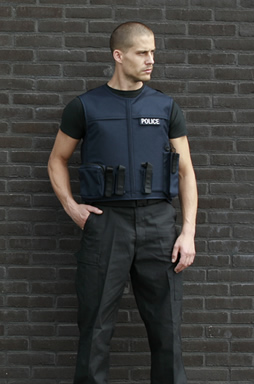New Bullet Proof Vest Technology – Better than Kevlar?
Posted by Extreme Tactical Dynamics on Jun 29th 2019
The Polish company Moratex, along with inventors at the Military Institute of Armament Technology in Warsaw, have come up with new applied science they say is better than Kevlar. The most unusual aspect scientists have discovered is the simple scientific procedure that it’s built on. To understand how Moratex’s innovative discovery could help stop a bullet and reduce damage to internal organs, you have to think about simple science experiments using cornstarch and water.
Non-Newtonian vs. Newtonian Fluids
Chances are you played with cornstarch and water as a kid. Whether your mom or an elementary science teacher helped you experiment with this oozy goop, you likely had an hour or so of fun and also learned a valuable lesson about non-Newtonian and Newtonian fluids.
Water is a Newtonian fluid, which means it won’t change its properties when stressed or sheared. In comparison, a combination of equal parts water and cornstarch creates a Non-Newtonian Fluid. The difference between the two is a non-Newtonian fluid becomes more viscous as pressure is applied.
Non-Newtonian fluids become gelatinous. The change occurs because of a subordination of particles in the liquid structure. In essence, a barrier is formed against any external, penetrating factor; such as a bullet. Examples of other non-Newtonian fluids include blood, gravy, ketchup, and even yogurt.
Shear-Thickening Fluid (STF)
 Moratex named their new technology, Shear-Thickening Fluid (STF). Although the company hasn’t revealed the exact formula for this potentially life-saving invention, there are a few things that have been announced. First, we know the STF looks like thick, maple syrup and is perfected with chemicals to create a viscosity that can stop bullets and other projectiles. Now that we know what STF is and how it can stop a bullet, it’s time to talk about how the substance is better than Kevlar.
Moratex named their new technology, Shear-Thickening Fluid (STF). Although the company hasn’t revealed the exact formula for this potentially life-saving invention, there are a few things that have been announced. First, we know the STF looks like thick, maple syrup and is perfected with chemicals to create a viscosity that can stop bullets and other projectiles. Now that we know what STF is and how it can stop a bullet, it’s time to talk about how the substance is better than Kevlar.
STF is Better than Kevlar at Protecting
First and foremost, when Kevlar and STF are compared side by side, STF is much lighter. It also doesn’t restrict movement like Kevlar does. The next biggest difference and where STF has a major advantage over Kevlar is what happens when the material stops a bullet.
A traditional Kevlar vest is made of many layers of synthetic fabric. When woven together, the layers are stronger than steel. Kevlar bullet-resistant vests can block a bullet, but sometimes warps or bends the bullet upwards, which can lead to a 4cm impact into the Kevlar materials. The impact can send a shockwave through the wearer’s body. Depending on the type of ammunition and the distance at which it was shot, the wearer of the vest can experience a shockwave that can damage internal organs.
STF works differently because it stops a shot in an entirely different manner. Instead of just preventing the bullet from penetrating the wearer’s body, it absorbs the impact of the bullet. As a result, effects felt by the wearer are decreased from 4cm to just 1cm. By absorbing the consequences of the bullet, the aftershock felt by a person wearing a bulletproof vest enforced with Kevlar is almost eliminated.
While the technology used to keep police and soldiers safe is always changing, so is the technology around ammunition and other weapons. For this reason, shear thickening fluid is one of the first significant changes in protective, ballistic vest, but certainly not the last.
We’ll keep you posted as new developments occur.
Related Posts
- Can Civilians Use Police Flashing Lights?
- Drones allow Firefighters to train better and save lives faster
- FIRST RESPONDERS AND KIDS at the HOLIDAY SEASON
- The Perfect Holiday Gift for your First Responder
- Blazing Infernos – California, Oct. 2017
- K9 Police Officers and their Dogs
 Facebook
Twitter
Google+
Instagram
YouTube
Facebook
Twitter
Google+
Instagram
YouTube

